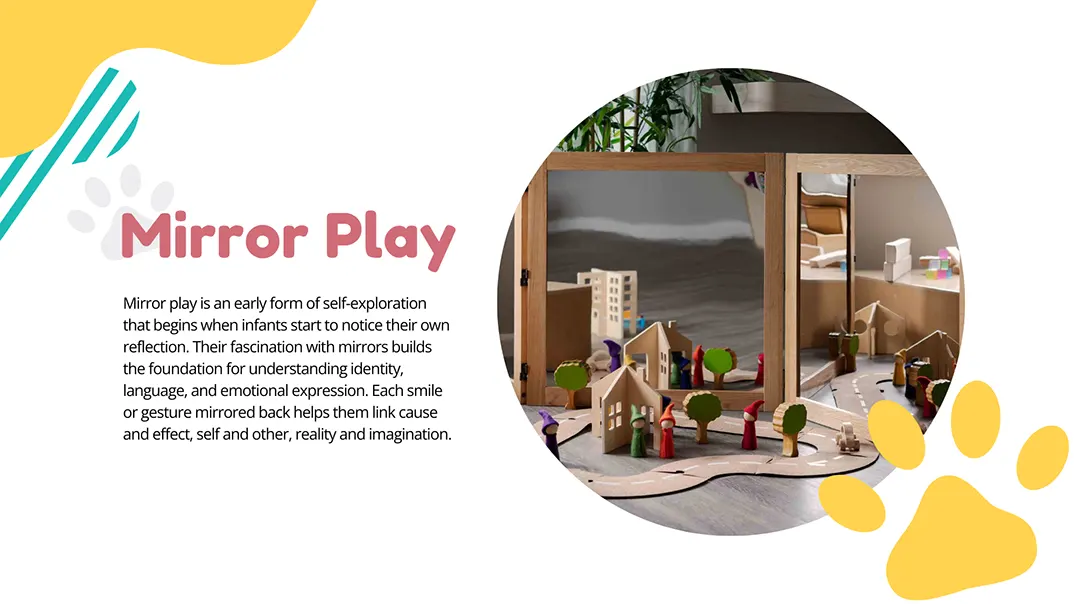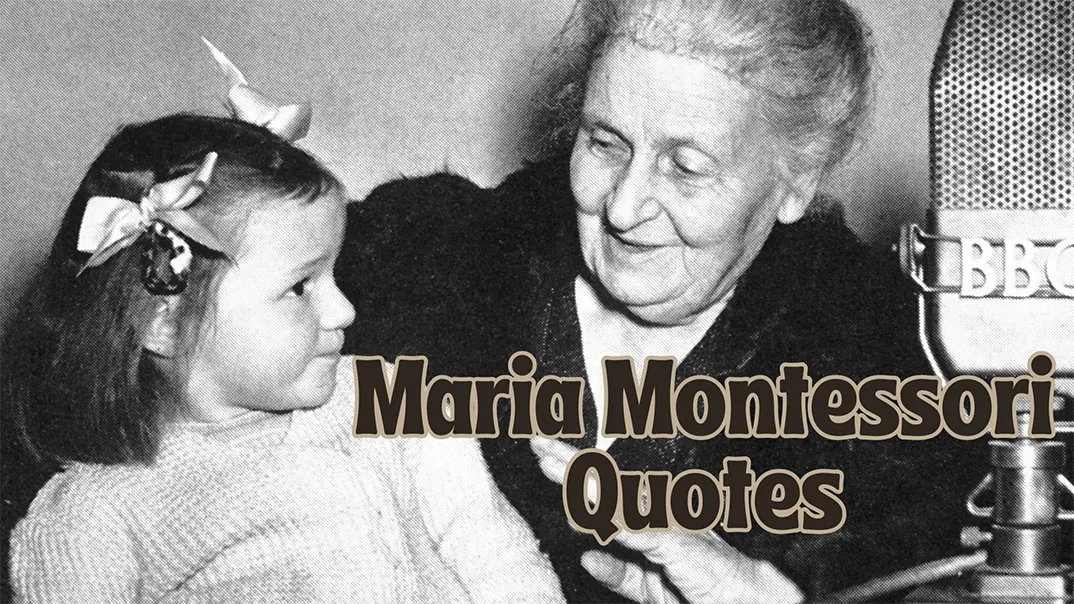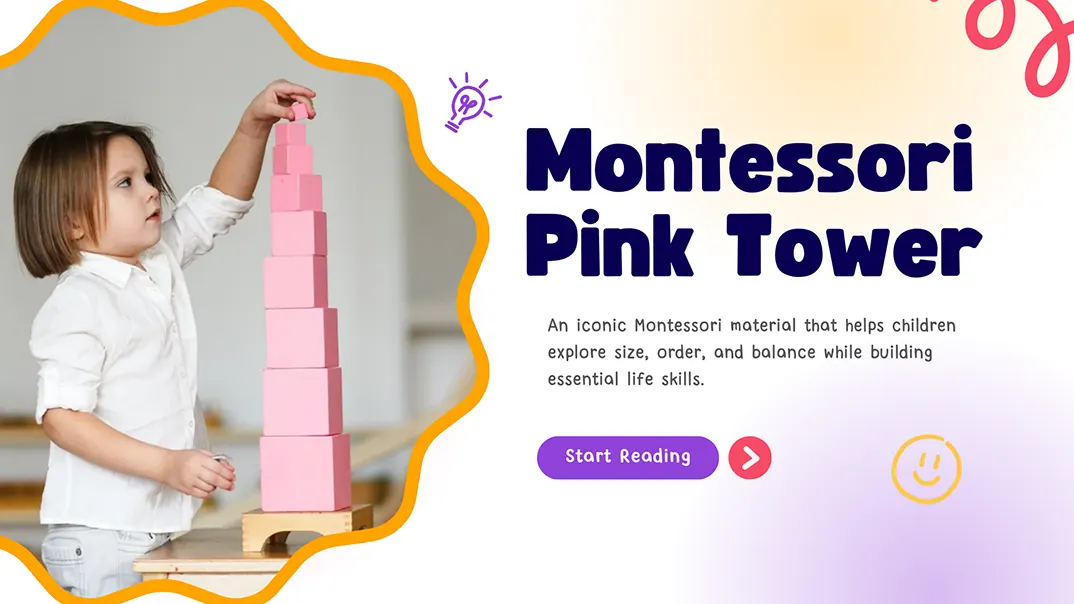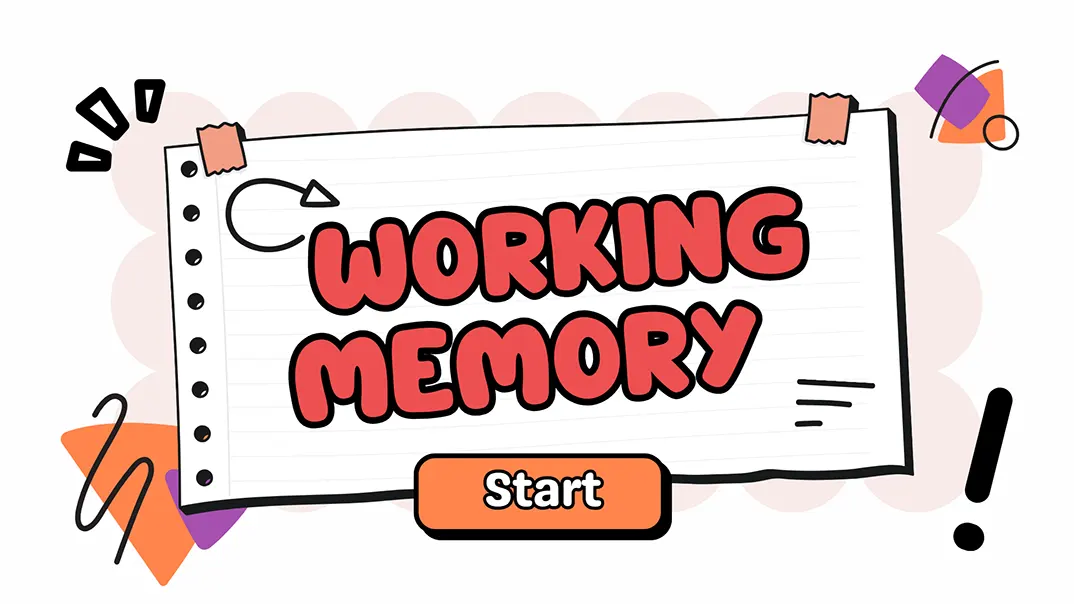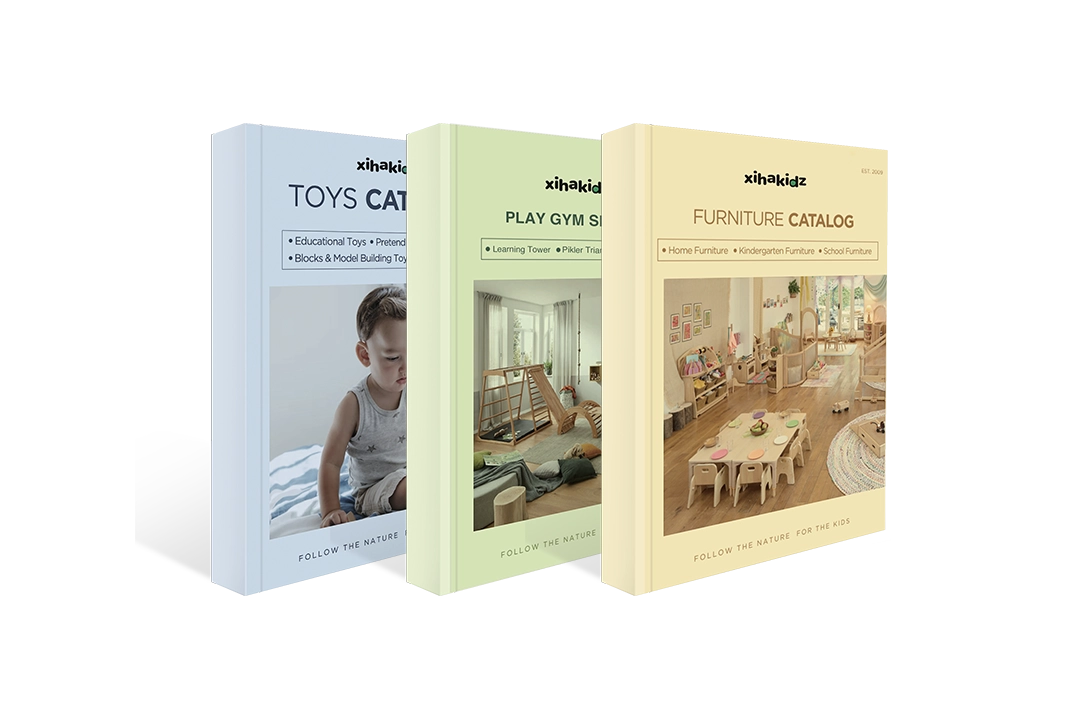Have you ever wondered what makes a Montessori classroom truly effective? Do you want to create an environment that fosters independence, creativity, and engagement? It’s not just about the curriculum but also about how the Montessori classroom layout is thoughtfully designed to encourage independent learning, exploration, and personal growth.
Creating a thriving Montessori classroom requires more than just setting up desks and chairs. Every corner should inspire curiosity, and each material should be carefully chosen to encourage self-direction. Planning and organizing your Montessori classroom layout with intention gives children the freedom to explore and learn at their own pace, building skills that will serve them for life.
This article will explore 12 essential tips for planning and organizing a Montessori classroom layout. From setting up learning zones to selecting the right materials, these tips will help you create a harmonious space where children can develop their independence and love for learning.
Key Elements of the Montessori Environment
The Montessori environment is carefully designed to foster independence, curiosity, and a love for learning. Unlike traditional classrooms, it emphasizes self-directed exploration, individualized learning paths, and hands-on experiences that connect education to real life. Through a peaceful and respectful atmosphere, children develop essential skills at their own pace, following a continuous learning cycle that nurtures academic and personal growth.
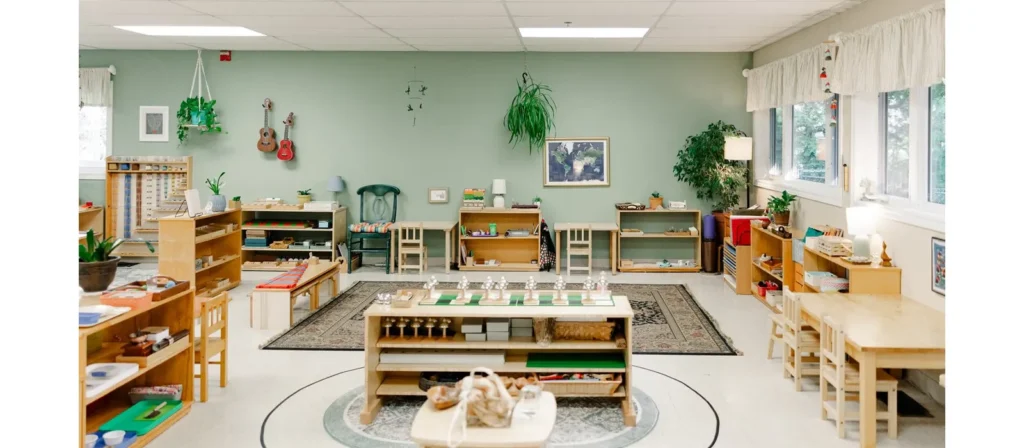
1. Emphasis on Self-Directed Learning
In a Montessori classroom, children take the initiative by choosing activities that interest them. Instead of following a fixed curriculum, they explore various options at their own pace. This self-directed approach fosters independence, motivation, and responsibility for their education.
2. Individualized Learning Paths
Each child in a Montessori environment is recognized as having unique learning needs and styles. Teachers observe children closely to understand their strengths, weaknesses, and interests. Based on these observations, they can guide children toward appropriate materials and activities for their individual development. The environment is structured to accommodate these different levels, allowing children to progress at their own speed.
3. Integration of Real-World Concepts
Educazione Montessori aims to connect learning with real-life experiences. The environment is filled with materials and activities that mimic practical situations. In practical life, children do tasks like sewing buttons, polishing silverware, or tying shoelaces. These activities develop fine motor skills and instill a sense of practicality and preparedness for everyday life. In the cultural studies section, children might learn about different countries and their traditions through maps, flags, and traditional artifacts, making the learning relevant and engaging.
4. Continuous Learning Cycle
The Montessori environment is designed to support a continuous learning cycle. Children start by exploring materials, and then they practice and master the skills related to those materials. As they gain confidence, they can apply what they have learned in new and more complex situations. This learning cycle is repeated across different curriculum areas, enabling children to build a solid foundation of knowledge and skills.
5. Peaceful and Respectful Atmosphere
The Montessori environment strongly emphasizes creating a peaceful and respectful space. Teachers model respectful behavior towards children, and children are taught to respect each other and the materials in the classroom. There are clear rules and expectations regarding behavior, such as walking quietly, using materials gently, and listening attentively when others speak. This respectful atmosphere helps build positive social relationships and community among the students.
The Basics of Montessori Classroom Layout Principles
UN Montessori classroom layout fosters independence, engagement, and a sense of order, creating the ideal space for children to learn and grow. The layout follows key principles that create a structured yet flexible environment for children.
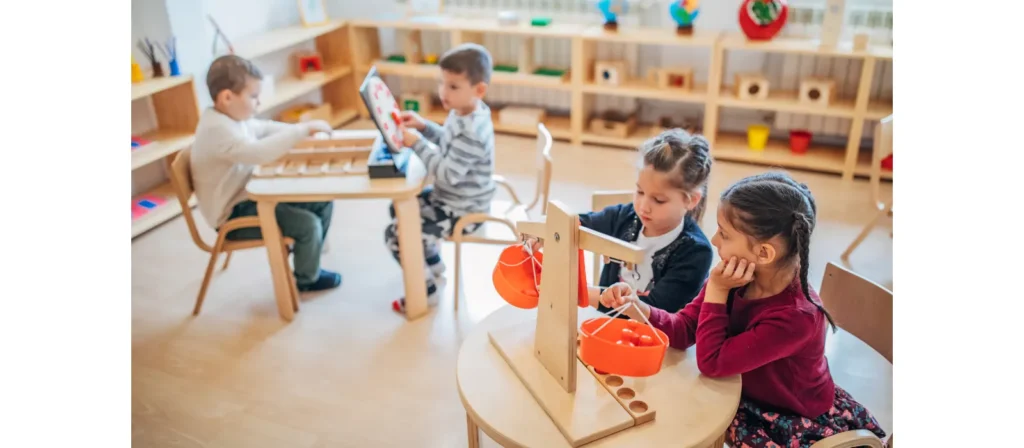
Freedom of Movement
- Open Space: The Montessori classroom layout has enough space for children to move freely and carry materials without obstruction.
- Clear Pathways: Walkways are wide and unobstructed, ensuring smooth transitions between learning areas like practical life and language stations.
Organization and Order
- Logical Material Arrangement: Montessori materials are placed in a sequence from simple to complex, helping children grasp concepts step by step.
- Defined Areas: Each learning area (practical life, sensorial, math, language, cultural studies) is designated for easy navigation.
Accessibilità
- Low Shelving: Materials are placed on child-height shelves so children can independently choose and return items.
- Visible Materials: Everything is displayed openly (not in drawers), making selection easy and intuitive.
Beauty and Harmony
- Materiali naturali: Wooden furniture, cotton rugs, and soft fabrics create a warm, inviting atmosphere.
- Soft Colors: Earth tones and muted colors minimize distractions and promote focus.
Flessibilità
- Movable Furniture: Lightweight tables and chairs allow the layout to change based on activities.
- Multi-Purpose Spaces: Areas can serve different functions throughout the day, such as reading corners turning into science stations.
Balance and Proportion
- Appropriate Sizing: The size of each learning area matches the children’s needs.
- Visual Balance: The Montessori classroom layout is arranged harmoniously, ensuring a calm and inviting learning environment.
12 Montessori Classroom Layout Tips
These tips will help you optimize your space, making it functional and inspiring. Whether you’re a new Montessori educator or an experienced one looking to refresh your space, these insights will guide you in creating a nurturing, child-centered environment.
1. Start with a Clear Montessori Vision
Before moving furniture or arranging materials, you must clearly understand the Montessori philosophy and how it influences classroom design. A Aula Montessori layout fosters independence, respect for others, and self-directed learning.
Begin by setting goals for your classroom that align with Montessori principles. What type of activities do you want to encourage? Will you create specific areas for practical life skills or sensorial exploration? Start with these broad goals and then design your Montessori classroom layout to support them.
A clear Montessori vision will guide your furniture placement, material organization, and overall classroom structure. A cohesive vision ensures that every design choice supports your teaching approach and maximizes student growth potential.
2. Prioritize Open Space for Movement
One of the most important elements in a Montessori classroom layout is the emphasis on movement. Children in Montessori environments are encouraged to move freely throughout the space, explore materials, and interact with their peers. To support this, you should prioritize open spaces for movement and play.
Avoid overcrowding the room with unnecessary furniture or materials. Instead, aim to create clear pathways that allow children to move easily between areas. The layout should provide a sense of openness, allowing children to explore at their own pace without the constraints of tightly packed furniture.
- Keep pathways clear to allow free movement.
- Avoid placing furniture in a way that creates dead-end spaces.
- Use low, open shelves instead of large cabinets to maintain an airy feel.
- Arrange materials neatly and in an accessible manner.
3. Create Defined Learning Areas
Montessori classrooms often feature specific areas dedicated to different activities. For instance, the Practical Life area, the Sensorial area, the Math area, and the Language area each require distinct arrangements to allow children to engage with materials and activities in an organized way.
Define each area clearly within the classroom using furniture or rugs to separate spaces. Arrange materials by category and place them within easy reach of the children. Label the areas and materials in a way that supports independence and helps children know where to find what they need.
Creating these defined learning zones allows children to choose the most interesting activity and helps them stay focused. This structured yet flexible arrangement fosters a sense of order while offering freedom of choice.
Area della vita pratica
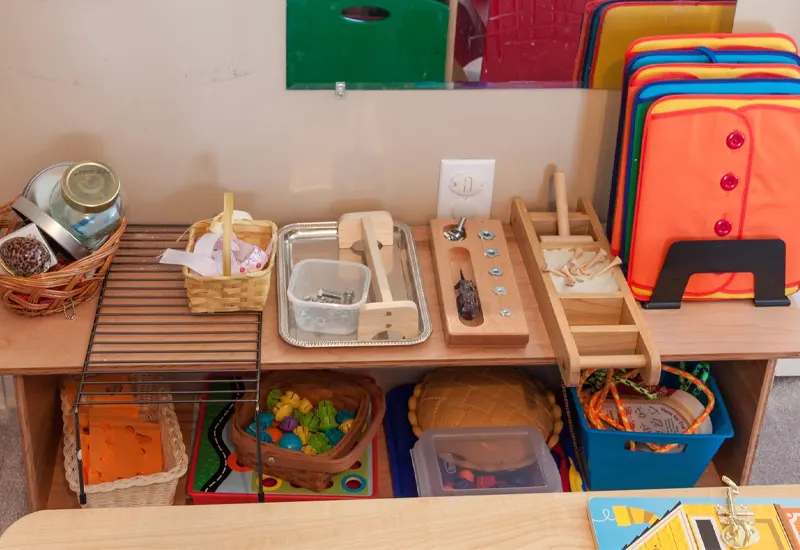
- Encourages children to take initiative and care for their environment.
- Designed to resemble a home setting with child-scaled furniture.
- Arranged to promote order and independence through everyday tasks.
- Activities include pouring, sweeping, and dressing, emphasizing fine motor skills.
Sensorial Area
- Aids in developing critical thinking and pre-math skills.
- Features a variety of sensory materials sorted from simple to complex.
- The layout was designed to enhance sensory discrimination and observation.
- Activities involve sorting, grading, and matching by size, shape, and color.
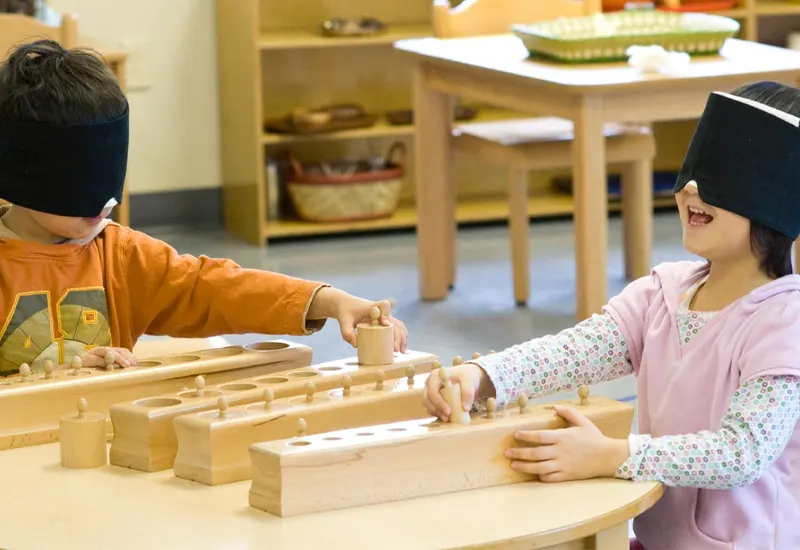
Language Area
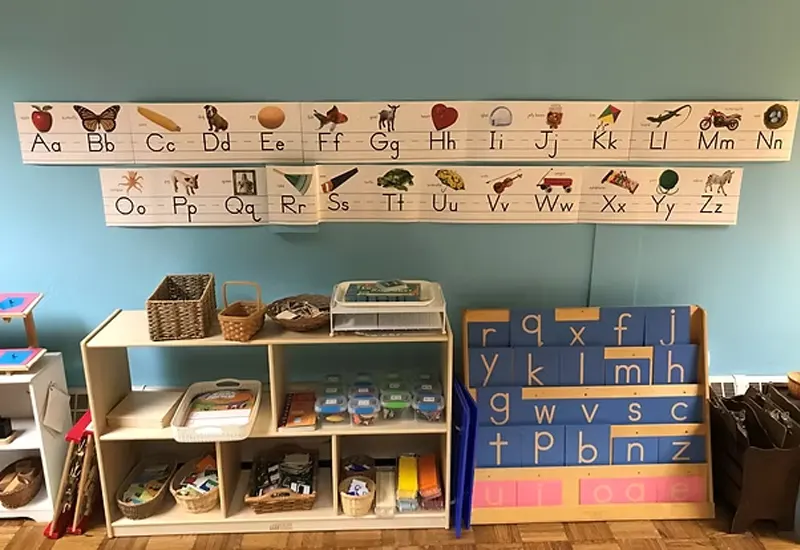
- Supports phonetic learning, vocabulary expansion, and grammatical structure.
- Organized to facilitate the progressive acquisition of reading and writing.
- Includes tools like sandpaper letters and movable alphabets for tactile learning.
- Sequential setup from single letters to words to full sentences.
Mathematics Area
- Develops a foundational understanding of geometry and spatial awareness.
- Sequentially presents materials that build from concrete to abstract concepts.
- Includes tactile tools like beads and rods to visualize and solve math problems.
- Encourages understanding of numbers, counting, and basic operations.
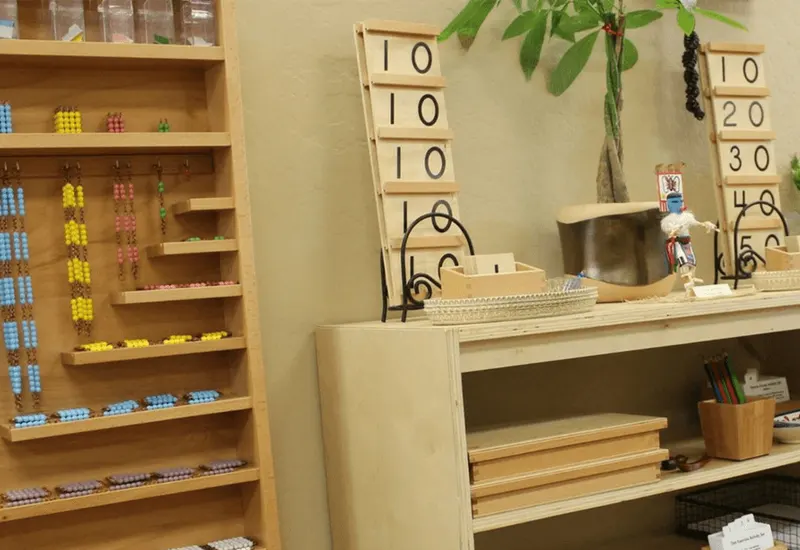
Cultural Area
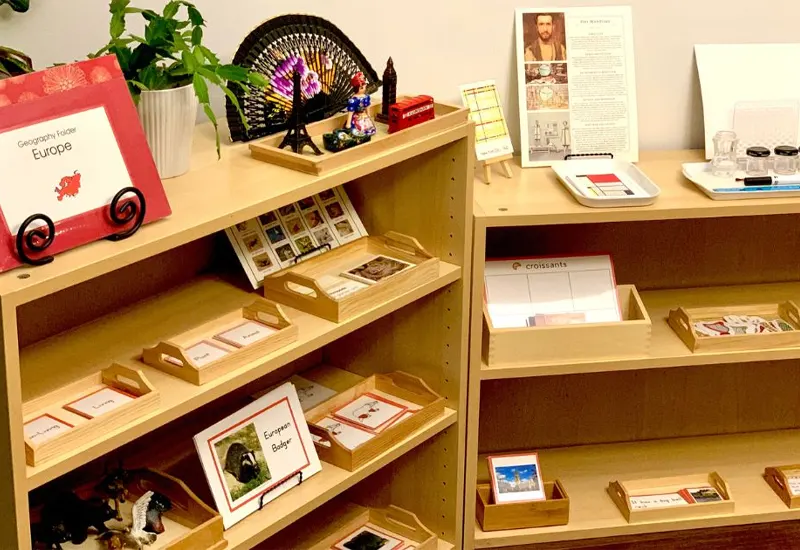
- Designed to expose children to various cultures, natural sciences, and geography.
- Features maps, flags, cultural artifacts, and biological specimens to explore diversity.
- Activities include puzzle maps, landforms, and studies of flora and fauna.
- Promotes awareness and appreciation of global diversity and scientific concepts.
4. Use Child-Sized and Accessible Furniture
One of the hallmarks of a Montessori classroom layout is that it is tailored to the needs of the children. This means using mobili per bambini that allows children to engage with their environment comfortably. Low tables, small chairs, and accessible shelves all promote independence and make it easier for children to move around and interact with materials.
Furniture placement is equally important. For example, a low table where children can gather for group activities should be placed in a space that allows easy movement and access to surrounding areas. Shelves should be arranged at child height so children can independently choose materials without adult assistance.
Using appropriately scaled furniture to the children’s size promotes a sense of autonomy, encouraging children to take responsibility for their learning and environment.
- Use lightweight chairs and tables that children can move independently.
- Ensure shelves are at a reachable height so children can access and return materials without adult help.
- Avoid bulky furniture that may restrict movement.
Trasforma la tua aula con soluzioni di arredamento personalizzate
5. Keep Materials Organized and Rotated
An organized classroom is key to maintaining a calm and focused environment. Montessori classroom layout should feature low, accessible shelves where materials are neatly arranged and easy to reach. The organization of materials reflects the classroom’s orderliness, directly impacting children’s ability to focus and engage.
Materials should be organized by category and placed on the shelves so that children can easily choose what they wish to work with. Be sure to rotate materials regularly to maintain interest and prevent boredom. This keeps the Montessori classroom layout dynamic and ensures children can always access new challenges.
Additionally, less is more. Avoid overwhelming children with too many materials at once. Instead, choose a few high-quality items that support the learning goals of each area.
6. Incorporate Natural Elements
The Montessori philosophy emphasizes connection to nature, extending to the Montessori classroom layout. Incorporating natural elements like wood, plants, and natural light can help create a calming and stimulating environment. Natural materials, such as wooden furniture, natural fabrics, and plants, provide sensory experiences that engage children meaningfully.
Plants, in particular, are a great addition to any Montessori classroom layout. They help purify the air and teach children about responsibility, as they are often tasked with caring for them. Include natural textures and colors to create a more inviting and grounding atmosphere.
Incorporating nature into your Montessori classroom layout encourages children to respect the environment and create a space that feels organic, nurturing, and connected to the world around them.
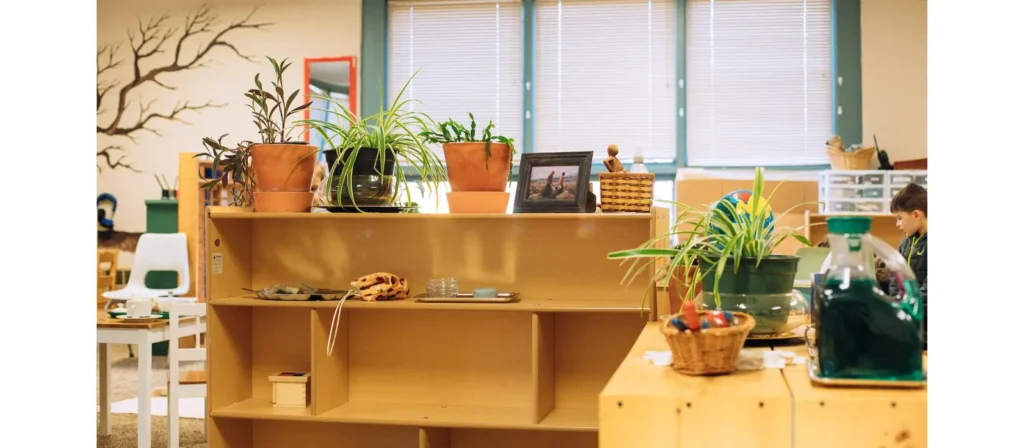
7. Ensure Proper Lighting and Color Selection
Lighting is crucial in any classroom, especially in Montessori environments, where children must focus and engage with materials. Natural light is ideal, as it supports focus and emotional well-being. If possible, position your furniture near windows to allow maximum luce naturale.
If natural light is limited, ensure that your artificial lighting is warm and soft, avoiding harsh overhead lighting that can create a distracting or uncomfortable atmosphere.
Color selection is equally important in setting the tone of the room. Soft, neutral colors like light beige, soft greens, and pastels create a calming and focused environment. Avoid bright, overwhelming colors that can distract children from their work.
8. Include Comfortable Reading and Quiet Areas
A quiet, comfortable space is essential for fostering concentration and reflection. This often forms a cozy reading nook or a quiet area where children can rest or reflect in a Montessori classroom layout. This area should be away from the noise and bustle of other learning areas, providing a space for quiet moments.
- Use soft cushions, rugs, or bean bags to create a cozy setting.
- Display books on forward-facing shelves so children can easily see the covers.
- Rotate books regularly to maintain interest.

9. Adapt the Montessori Classroom Layout as Children Grow and Develop
A Montessori classroom is not a static environment—it should evolve alongside the children who use it. As children grow, their physical, cognitive, and social needs change, requiring thoughtful adjustments to the Montessori classroom layout. Younger children need low shelves, small tables, and hands-on materials, while older students benefit from larger workspaces, advanced learning materials, and collaborative areas.
Educators can gradually introduce more complex activities and rearrange the space to support these changes and encourage independence.
- Observe how children interact with the space and identify any obstacles.
- Rearrange shelves or seating to better accommodate their needs.
- Introduce new materials that align with their developmental stages.
10. Maintain a Minimalist and Clutter-Free Space
A minimalist Montessori classroom layout is aesthetically pleasing and promotes focus and clarity. A cluttered, chaotic space can overwhelm children and make it difficult for them to concentrate. Keep materials and furniture to a minimum, focusing on quality rather than quantity.
Organize materials by category and only display what is necessary. Over time, you’ll find that rotating materials rather than displaying everything simultaneously helps maintain a calm environment. Regularly declutter and reassess your Montessori classroom setup to ensure it remains orderly and functional.
11. Foster a Sense of Community
A well-designed Montessori classroom layout supports individual learning and nurtures a strong sense of community. Children develop cooperation, empathy, and a sense of belonging by intentionally creating shared spaces. Arranging communal tables, open gathering areas, and collaborative workstations encourages peer interaction and teamwork, fostering a culture of respect and shared responsibility.
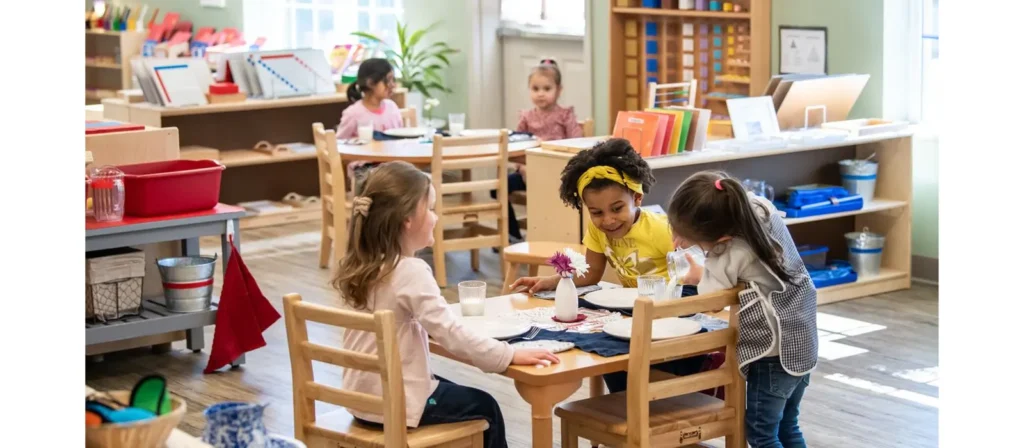
Incorporating group projects, classroom meetings, and peer mentoring further strengthens this sense of community. Younger children benefit from observing and learning from older students, while older students develop leadership and teaching skills. This multi-age dynamic, a core Montessori principle, thrives in a classroom layout that facilitates natural, cooperative engagement.
A dedicated peace or conflict-resolution area can help children practice communication and problem-solving skills. When the Montessori classroom layout supports meaningful connections, students feel valued as active learning community members, creating a positive and inclusive environment.
12. Display Child-Created Work and Real-Life Objects
Showcasing children’s work in the Montessori classroom layout fosters a sense of pride, ownership, and accomplishment. Instead of commercial posters or pre-made decorations, display artwork, crafts, and projects made by the students. This reinforces the idea that their contributions are valuable and encourages creativity.
In addition to student work, incorporate real-life objects that inspire curiosity and learning. Use high-quality images of real people, places, and things instead of cartoonish representations. Items like nature collections, cultural artifacts, and everyday tools help children connect learning to the real world, making concepts more tangible and meaningful.
A thoughtfully curated Montessori classroom layout with authentic materials and student work creates a space where children feel respected and engaged. It encourages exploration, supports hands-on learning, and builds confidence as students see their progress and contributions reflected in their surroundings.
Montessori Classroom Layout Example
A well-designed Montessori classroom layout fosters independence, movement, and hands-on learning. It includes clearly defined areas for Practical Life, Sensorial, Language, Mathematics, and Cultural Studies, each with accessible materials on low shelves. Open floor space, child-sized furniture, and a cozy reading nook create an inviting atmosphere. Natural lighting and a clutter-free environment promote focus and engagement, ensuring children can explore and learn independently.
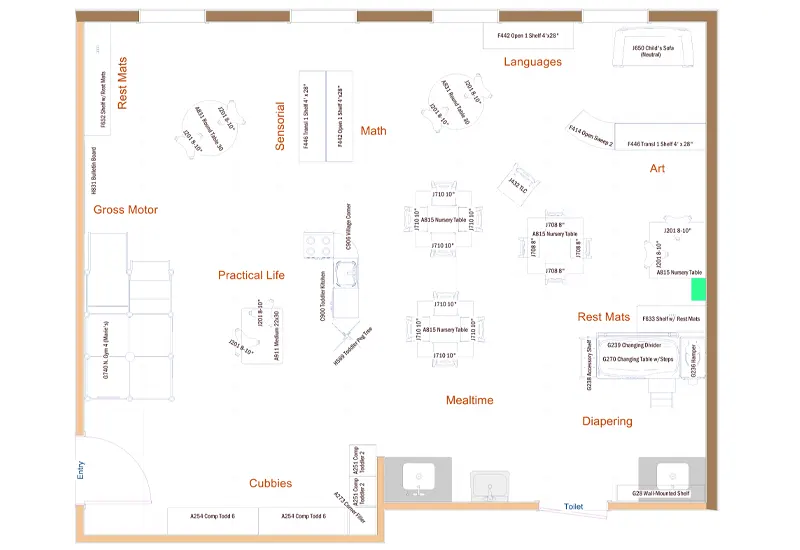

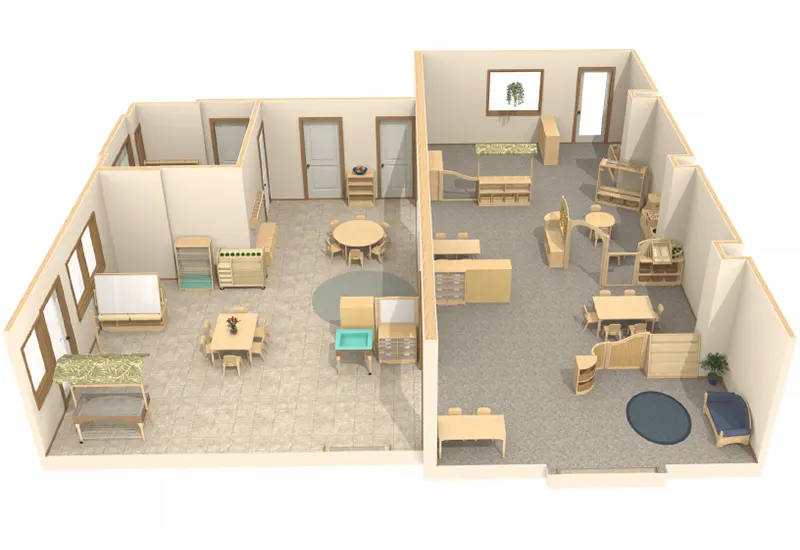

Trasforma la tua aula con soluzioni di arredamento personalizzate
Montessori Classroom vs Traditional Classroom
To better understand the differences between a Montessori classroom and a traditional classroom, here is a simple comparison table:
| Caratteristica | Montessori Classroom | Traditional Classroom |
|---|---|---|
| Learning Approach | Child-centered, hands-on learning | Teacher-led, textbook-based learning |
| Classroom Layout | Open, flexible, with learning zones | Rows of desks facing the teacher |
| Ruolo dell'insegnante | Guide and observer | Instructor and authority figure |
| Student Independence | Encouraged self-directed activities | Structured lessons, limited choices |
| Age Grouping | Mixed-age groups (3-year spans) | Same-age grouping |
| Materiali utilizzati | Montessori-specific, tactile materials | Worksheets, textbooks, and digital tools |
| Valutazione | Observation-based, no grades or tests | Standardized testing and grading |
The Montessori classroom layout is intentionally designed to foster movement, independence, and hands-on learning. Instead of fixed desks arranged in rows, the space is open and divided into distinct learning areas, such as Practical Life, Sensorial, Mathematics, Language, and Cultural Studies. Low, open shelves house carefully selected materials, allowing children to choose their work independently. Floor space is essential to the design, as many activities occur on mats rather than at tables.
In contrast, the traditional classroom layout follows a more rigid structure. Desks are typically arranged in rows, all facing the teacher at the front of the room. The teacher’s desk is a central authority figure, reinforcing a teacher-led approach. Materials and resources are usually stored out of students’ reach, requiring teacher permission for access. Movement is limited, and students must stay seated for most of the lesson.
Furniture choices also reflect the differing philosophies. Montessori classrooms use child-sized tables and chairs that can be moved freely, supporting collaboration and independent work. Many tasks are performed on the floor, encouraging physical engagement with learning materials. Traditional classrooms, however, use standard-sized desks and chairs, which remain fixed in place, emphasizing a more structured and uniform learning experience.
Another key difference is how students interact with their environment. In a Montessori setting, children are encouraged to move throughout the classroom, selecting activities based on their interests. Workstations are spread across the room, allowing for a more dynamic and interactive experience. Traditional classrooms, on the other hand, prioritize order and discipline, with students primarily working at their desks. Movement is restricted to designated times, such as recess or group activities.
By prioritizing accessibility, independence, and flexibility, the Montessori classroom layout creates an environment that naturally supports active learning. Unlike the rigid structure of traditional classrooms, the Montessori classroom layout adapts to the child’s developmental needs, making learning an engaging and self-directed experience.
Conclusione
Designing a Montessori classroom layout requires careful planning to create an environment that fosters independence, exploration, and learning. By focusing on organization, accessibility, and a well-structured flow, we can provide children with a space that nurtures their natural curiosity. A thoughtfully arranged classroom supports both practical functionality and the Montessori philosophy, ensuring an engaging and effective learning environment for young minds.
At XihaKidz, we specialize in high-quality Montessori and kindergarten furniture that helps educators create the perfect learning space. Our expertly designed products ensure safety, durability, and functionality, making implementing an effective Montessori classroom layout easier. Let us help you bring your vision to life!
Scopri la nostra gamma completa di prodotti
Accedi al nostro catalogo completo con mobili e attrezzature da gioco di alta qualità per asili e scuole.



